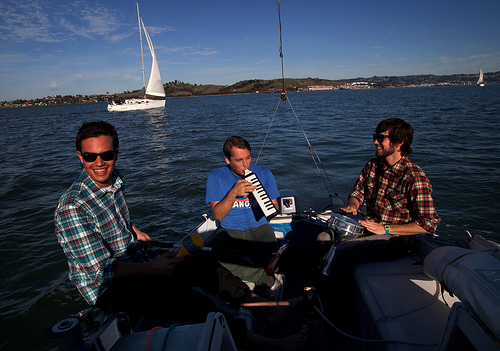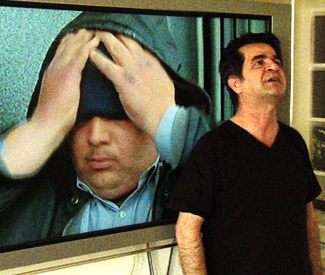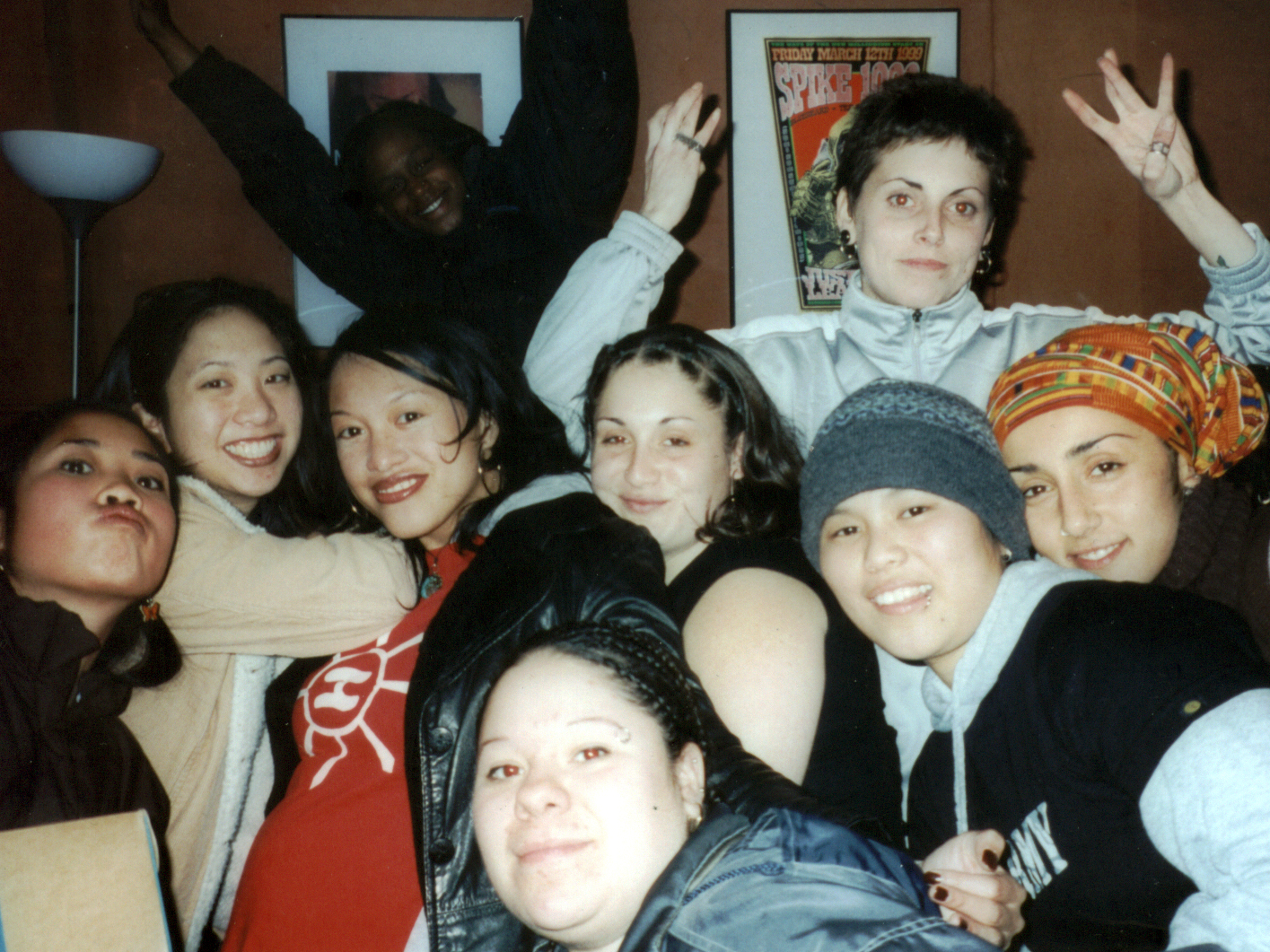Music listings are compiled by Emily Savage. Since club life is unpredictable, it’s a good idea to call ahead or check the venue’s website to confirm bookings and hours. Prices are listed when provided to us. Visit www.sfbg.com/venue-guide for venue information. Submit items for the listings at listings@sfbg.com. For further information on how to submit items for the listings, see Picks.
WEDNESDAY 11
ROCK/BLUES/HIP-HOP
Bro Blues Jam with Chris Cain Biscuits and Blues. 8 and 10pm, $15.
Caravan of Thieves, Demolition String Band Hotel Utah. 9pm.
Cha-Ching Boom Boom Room. 9pm, $5.
Damir Johnny Foley’s. 9pm, free.
FIREHOSE, Tera Melos, Glimpse Trio Slim’s. 8pm, $21.
Foxtails Brigade, Emily Jane White, Paula Frazer Cafe Du Nord. 9:30pm, $10.
Girls Bimbo’s. 9pm, $25.
Girls With Guns, Go Going Gone Girls, Chuckleberries Elbo Room. 9pm, $7.
Lee Ranaldo Band (of Sonic Youth) Brick and Mortar Music Hall. 9pm, $15-$20.
Oberhofer, POND, PreTeen Rickshaw Stop. 8pm, $10-$12.
Sepultura, Death Angel DNA Lounge. 7:30pm, $25.
Train Great American Music Hall. 8pm, $35.
Vanishing Breed, Tiger Honey Pot, White Barons Hemlock Tavern. 9pm, $6.
M. Ward, Jonathan Richman Fillmore. 8pm, $30.
Greg Zema vs. Rags Tuttle Johnny Foley’s Dueling Pianos. 9:30pm.
JAZZ/NEW MUSIC
Benny Golson Quintet Rrazz Room. 8pm, $40-$45.
Chris Amberger Trio Yoshi’s SF Lounge. 6:30 and 9:30pm.
Cosmo AlleyCats Le Colonial, 20 Cosmo Place, SF; www.lecolonialsf.com. 7-10pm.
Dink Dink Dink, Gaucho, Michael Abraham Amnesia. 7pm, free.
Dohee Lee Meridian Gallery, 535 Powell, SF; www.meridiangallery.org. 7:30-930pm.
Ted Nash Yoshi’s SF. 8pm, $18.
Ricardo Scales Top of the Mark, 999 California, SF; www.topofthemark.com. 6:30pm, $5.
DANCE CLUBS
Booty Call Q-Bar, 456 Castro, SF; www.bootycallwednesdays.com. 9pm. Juanita MORE! and Joshua J host this dance party.
Coo-Yah! Som., 2925 16th St, SF; (415) 558-8521. 10pm, free. DJs Daneekah and Green B spin reggae and dancehall with weekly guests.
Get Low Madrone Art Bar, 500 Divisadero, SF; www.madroneartbar.com. 10pm. Jerry Nice & the Wild N Krazy Kids spin ’90s R&B.
KUSF-in-Exile DJ Night Monarch, 101 Sixth St., SF; www.savekusf.org. 5:30-9:30pm.
Mary Go Round Lookout, 3600 16th St, SF; www.lookoutsf.com. 10pm, $5. Drag with Suppositori Spelling, Mercedez Munro, and Ginger Snap.
Megatallica Fiddler’s Green, 1333 Columbus, SF; www.megatallica.com. 7pm, free. Heavy metal hangout.
Vespa Beat Bliss Bar, 4026 24th St., SF; www.blissbarsf.com. 9pm, free. MSK.fm spins raregrooves, electroswing, and boogie.
THURSDAY 12
ROCK/BLUES/HIP-HOP
Astral, Space Waves, Sundaze Hemlock Tavern. 9pm, $6.
Band of Skulls, We Are Augustines Fillmore. 8pm, $19.50.
Blood Orange Rickshaw Stop. 9:30pm, $12.
Dreamdate, Thee Bedfellows, Wrong Words Knockout. 9:30pm, $6.
Jerry Joseph & the Jackmormons, Boom Chick Cafe Du Nord. 9pm, $12-$15.
Mama D & the Dirty Suns, Cure for Gravity, Team Candy Bottom of the Hill. 9pm, $10.
Meat Market, Twin Steps, Buffalo Tooth, Religious Girls, Girls in Suede Thee Parkside. 9pm, $6.
Mercy Fists, Magic Brook, Shawn Brown Red Devil Lounge. 7pm, $13.
Melvins, Unsane Great American Music Hall. 9pm, $21.
Metronomy, Cuckoo Chaos Slim’s. 9pm, $16.
Rolando Morales Biscuits and Blues. 8 and 10pm, $16.
Paul Pot and Dennis D. Lost Church, 65 Capp, SF; www.thehappyclams.com. 8pm.
Lee Ranaldo Amoeba, 1855 Haight, SF; www.amoeba.com. 6pm, free.
JC Rockit vs. Guido Johnny Foley’s Dueling Pianos. 9:30pm.
Sandwitches, Deep Time, Muscle Drum Brick and Mortar Music Hall. 9pm, $10-$12.
Stan Erhart Band Johnny Foley’s. 9pm, free.
Train, Brad Brooks Bimbo’s. 8pm, $35.
"Vulpes Vulpes: Silverfox Concert for Good" CELLspace, 2050 Bryant, SF; 7pm, $40. SF Food Bank fundraiser with Buttercream Gang, Mahgeetah, Sun Life, and an open bar.
JAZZ/NEW MUSIC
Benny Golson Quintet Rrazz Room. 8pm, $40-$45.
Stompy Jones Top of the Mark, 999 California, SF; www.topofthemark.com. 7:30pm, $10.
"Just the Usual Suspects" 50 Mason Social House, SF; www.50mason.com. 7pm. With Cindy Lee Berryhill, Lily Holbrook, Jeff Desira, and Alex Jimenez.
Tom Lander and Friends Medjool, 2522 Mission, SF; www.medjoolsf.com. 6-9pm, free.
Grant Levin Yoshi’s SF Lounge. 6:30pm.
Ned Boynton Trio Bottle Cap, 1707 Powell, SF; www.bottlecapsf.com. 7-10pm.
FOLK/WORLD/COUNTRY
Front Country Atlas Cafe, 3049 20 St, SF; www.atlascafe.net. 8-10pm, free.
Alex Jimenez 50 Mason Social House, SF; www.50masonsocialhouse.com. 7pm, free.
Twang! Honky Tonk Fiddler’s Green, 1330 Columbus, SF; www.twanghonkytonk.com. 5pm. Live country music, dancing, and giveaways.
DANCE CLUBS
Afrolicious Elbo Room. 9:30pm, $5.With ArtOfficial, DJ Kung Fu Chris, and DJ/host Pleasuremaker spinning Afrobeat, Tropicália, electro, samba, and funk.
Darling Nikki Som. 9pm. Queer dance party with DJ Miss Pop, Dr. Sleep, and Justin Credible.
Get Low Som., 2925 16th St, SF; (415) 558-8521. 10pm, free. Jerry Nice and Ant-1 spin Hip-Hop, 80’s and Soul with weekly guests.
Get Lucky Lookout, 3600 16 St, SF; Facebook: Get Lucky. 9pm, free. DJs Six and Candy spin indie electro.
INTL: Cumbia & Moombahton con Shawn Reynaldo Public Works. 9pm.
Lions, Tigers, and Queers Underground SF. 10pm-2am, $3. Indie, electro, and House dance party with resident DJ Becky Knox and special guests.
Sol’s BIG Hawaii Five-O Mighty. 9pm, $5. DJs from Space Cowboys, Distrikt, Nu Funk Boutique, and WhiteNoize.
Thursdays at the Cat Club Cat Club. 9pm, $6 (free before 9:30pm). The best of ’80s mainstream and underground with DJs Damon, Steve Washington, and Dangerous Dan.
Tropicana Madrone Art Bar. 9pm, free. Salsa, cumbia, reggaeton, and more with DJs Don Bustamante, Apocolypto, Sr. Saen, Santero, and Mr. E.
FRIDAY 13
ROCK/BLUES/HIP-HOP
Brokedown in Bakersfield, Paula Frazer, He’s My Brother She’s My Sister Great American Music Hall. 9pm, $17.
Brownout, Chucho Santamaria, DJ Senor Oz Elbo Room. 10pm, $12.
Cannons and Clouds, Tartufi, Echo Location Rickshaw Stop. 9pm, $10.
Alex Gross, Will Knox, Jake Hill Amnesia. 6-9pm, $5.
Damien Jurado, Peter Wolf Crier, Dear Indugu Bottom of the Hill. 9pm, $12.
Malice Cooper, Trouble With Monkeys. Chick Jagger, Sticky Fingers Thee Parkside. 9pm, $6.
Maus Haus Knockout. 9pm.
Merchandise, Rat Columns, Neo-Cons, Wild Moth Hemlock Tavern. 9:30pm, $7.
Modeselektor 103 Harriet, SF; www.1015.com. 10pm.
Nero, Dillon Francis Warfield. 9pm, $37.50-$50.
Anders Osborne, Tracorum, Fiver Brown Brick and Mortar Music Hall. 9pm, $20-$25.
Jackie Payne Biscuits and Blues. 8 and 10pm, $20.
Polyrhythmics, Shakers Boom Boom Room. 8pm, $15.
Tall Shadows Johnny Foley’s. 9pm, free.
Nathan Temby, Jason Marion, JC Rockit Johnny Foley’s Dueling Pianos. 9pm.
Train, Tom Luce Slim’s. 9pm, $35.
Yonder Mountain String Band, Brown Bird Fillmore. 9pm, $25.
JAZZ/NEW MUSIC
Audium 1616 Bush, SF; www.audium.org. 8:30pm, $20. Theater of sound-sculptured space.
Black Market Jazz Orchestra Top of the Mark, 999 California, SF; www.topofthemark.com. 9pm, $10.
Terry Disely Bottle Cap, 1707 Powell, SF; www.bottlecapsf.com. 5:30-8:30pm.
Najee Yoshi’s SF. 8pm, $32; 10pm, $26.
Ways and Means Committee Yoshi’s SF Lounge. 6:30pm.
FOLK/WORLD/COUNTRY
Benny Golson Quintet Rrazz Room. 8pm, $40-$45.
Coelho & Ridnell, Will Magid, Sambaxe, Mondo Loko Cafe Du Nord. 9:30pm, $12.
Taste Fridays 650 Indiana, SF; www.tastefridays.com. 8pm, $18. Salsa and bachata dance lessons, live music.
Andy Wagner Velo Rouge Cafe, 798 Aruello, SF; www.velorougecafe.com. 7pm.
DANCE CLUBS
Friday All-Sorts Nickies Bar, 466 Haight, SF. 10pm, free. DJs spins new wave, hip-hop, and electro, with projections.
Indie Slash Amnesia. 10pm. With DJ Danny White.
Joe Lookout, 3600 16th St.,SF; www.lookoutsf.com. 9pm. Eight rotating DJs, shirt-off drink specials.
Old School JAMZ El Rio. 9pm. Fruit Stand DJs spinning old school funk, hip-hop, and R&B.
Paris to Dakar Little Baobab, 3388 19th St, SF; (415) 643-3558. 10pm, $5. Afro and world music with rotating DJs including Stepwise, Steve, Claude, Santero, and Elembe.
Pledge: Fraternal Lookout. 9pm, $3-$13. Benefiting LGBT and nonprofit organizations. Bottomless kegger cups and paddling booth with DJ Christopher B and DJ Brian Maier.
SATURDAY 14
ROCK/BLUES/HIP-HOP
Acid Mothers Temple, Phantom Family Halo, High Horse Bottom of the Hill. 10pm, $12.
Alcest, Giant Squid, Bryan Von Reuter Elbo Room. 4-8pm, $12.
Bay Area Heat Johnny Foley’s. 9pm, free.
Bite, My Parade, Black Boots Thee Parkside. 3pm, free.
Blame Sally, Lauren O’Connell Great American Music Hall. 8:30pm, $31-$36.
Blue Diamond Fillups Riptide, 3639 Taraval, SF; www.riptidesf.com. 10 and 11:15pm, free.
Richard Buckner, Tim Cohen Brick and Mortar Music Hall. 9pm, $17-$20.
DJ Konnex Pier 23 Cafe, SF; www.pier23cafe.com. 9pm, $10.
"Funk Out With Rock" Cafe Du Nord. 9pm, $15-$25. With Stymie and the Pimp Jones Luv Orchestra.
Funk Revival Orchestra Boom Boom Room. 8pm, $15.
Girls With Guns, Go Going Gone Girls, Chuckleberries Elbo Room. 9pm, $7.
Hot Lunch, Tropical Sleep, Superior Units Hemlock Tavern. 9:30pm, $7.
Lady Crooners Amnesia. 7pm, $5.
Meathook and the Vital Organs, Get Shot!, Inferno of Joy, Crunchees Thee Parkside. 9pm, $10. With Dancefloorjunkie Dolls Burlesque.
Nerv, Rock Bottom, Unmanned Pilots El Rio. 9pm, $7.
Rabbles, Future Twin, Slouching Stars, Apogee Sound Club El Rio. 3-8pm, $5-$10.
EC Scott Biscuits and Blues. 8 and 10pm, $20.
Sickoids, Merdoso, Bible Thumper, Proto-Regime, Beat Guts Knockout. 3-8pm, $7.
Rags Tuttle, Nathan Temby, Jason Marion Johnny Foley’s Dueling Pianos. 9pm.
White Buffalo, Hypnotist Collectors Slim’s. 9pm, $13-$15.
Yonder Mountain String Band, Brown Bird Fillmore. 9pm, $25.
JAZZ/NEW MUSIC
Audium 1616 Bush, SF; www.audium.org. 8:30pm, $20. Theater of sound-sculptured space.
"Heart& Soul" Rrazz Room. 7 and 9:30pm, $35-$45. Music of Diana Ross, Dionne Warwick, and Whitney Houston.
Michel Camilo Trio Herbst Theatre, 401 Van Ness, SF; www.sfjazz.org. 8pm, $19-$65.
Najee Yoshi’s SF. 8pm, $35; 10pm, $28.
Ways and Means Committee Yoshi’s SF Lounge. 6:30pm.
FOLK/WORLD/COUNTRY
Chimney Choir Plough and Stars. 9pm.
KC Turner Exit Theater, 56 Eddy, SF; www.kcturnermusic.com. 8:30pm, free.
Craig Ventresco & Meredith Axelrod Atlas Cafe, 3049 20 St, SF; www.atlascafe.net. 4-6pm, free.
DANCE CLUBS
BOOTIE SF: Hubba Hubba Revue DNA Lounge. 9pm, $10-$20. Mashup burlesque variety show.
Club Gossip Cat Club. 9pm, free before 9:30pm, $5-$8 after. With VJs Shon, Low Life, Damon, and more.
Cockblock Rickshaw Stop. 10pm, $5-$10.
Debaser Knockout. 9:30pm, $5, free with a flannel before 11pm. A look back at ’90s alternative rock.
INFERNO Harlot, 46 Minna, SF; www.infernodances.com. 6-10pm, $10. With DJ Rockaway.
One Nation Underground Monarch, 101 Sixth St, SF; www.residentadvisor.net. 9pm, $20. With Kenny Larkin and Monty Luke.
Paris to Dakar Little Baobab, 3388 19th St, SF; (415) 643-3558. 10pm, $5. Afro and world music with rotating DJs including Stepwise, Steve, Claude, Santero, and Elembe.
Tormenta Tropical Elbo Room. 10pm, $5-$10. With resident DJs Shawn Reynaoldo & Oro11, special guests DJ Rizzla and Tidal Wave.
2 Men Will Move You Amnesia. 9pm.
SUNDAY 15
ROCK/BLUES/HIP-HOP
Big Pink, New Diplomat Great American Music Hall. 8pm, $17.
Company of Thieves Cafe Du Nord. 8pm, $12.
Devotionals, Luke Sweeney, Tito Hemlock Tavern. 9pm, $6.
Givers, White Arrows Slim’s. 8pm, $17.
Pontiak, Electric Shepherd & Outlaw, White Cloud Bottom of the Hill. 9pm, $10.
Train, Finish Ticket Fillmore. 8pm, $35.
Yuck Independent. 8pm, $15.
JAZZ/NEW MUSIC
Stephanie Bruce, Brad Buethe, Fred Randolph Bliss Bar, 2086 24th St, SF; www.blissbarsf.com. 4:30pm, $10.
Hermann Lara and His Jazz Nexus Yoshi’s SF Lounge. 6:30pm.
Bettye Lavette Yoshi’s SF. 7pm, $30.
FOLK/WORLD/COUNTRY
Twang Sunday Thee Parkside. 4pm, free. With Shut Ins, Whiskey Pills Fiasco, Orb Mellon.
DANCE CLUBS
Batcave Club 93, 93 9th St, SF 10pm, $5. Death rock, goth, and post-punk with Steeplerot, XChrisT, Necromos and c_death.
Crackly Classic DJs Boom Boom Room.8pm, free. R&B, doo-wop, soul vinyl dance party.
Dub Mission Elbo Room. 9pm, $6.With Twilight Circus Dub Sound System aka Ryan Moore, and DJ Sep.
Jock Lookout, 3600 16th St, SF; www.lookoutsf.com. 3pm, $2. Raise money for LGBT sports teams while enjoying DJs and drink specials.
La Pachanga Blue Macaw, 2565 Mission, SF; www.thebluemacawsf.com. 6pm, $10. Salsa dance party with live Afro-Cuban salsa bands.
MONDAY 16
ROCK/BLUES/HIP-HOP
Godspeed You Black Emporer, Pierced Arrows Great American Music Hall. 8pm, $21.
Horrors, Black Angels, popscene DJs Nako and Omar Bimbo’s. 8pm, $25.
Kasabian, Hacienda Fillmore. 9pm, $22.50.
Dom Kennedy, Rich Hil, POLY Slim’s. 9pm, $19.
JAZZ/NEW MUSIC
Bossa Nova Tunnel Top, 601 Bush, SF; (415) 722-6620. 8-11:30pm, free. Live acoustic Bossa Nova.
David Correa and Cascada Yoshi’s SF Lounge. 6:30pm.
TEN-CHI-JIN Yoshi’s SF. 8pm, $20.
DANCE CLUBS
Death Guild DNA Lounge. 9:30pm, $3-5. Gothic, industrial, and synthpop with Joe Radio, Decay, and Melting Girl.
Krazy Mondays Beauty Bar, 2299 Mission, SF; www.thebeautybar.com. 10pm, free. Hip-hop and other stuff.
M.O.M. Madrone Art Bar. 6pm, free. DJs Timoteo Gigante, Gordo Cabeza, and Chris Phlek playing all Motown every Monday.
Sausage Party Rosamunde Sausage Grill, 2832 Mission, SF; (415) 970-9015. 6:30-9:30pm, free. DJ Dandy Dixon spins vintage rock, R&B, global beats, funk, and disco at this happy hour sausage-shack gig.
Vibes’N’Stuff El Amigo Bar, 3355 Mission, SF; (415) 852-0092. 10pm, free. Conscious jazz and hip-hop from 1960s-early ’90s with DJs Luce Lucy, Vinnie Esparza, and more.
TUESDAY 17
ROCK/BLUES/HIP-HOP
Butt Problems, Trashkannon, Psychology of Genocide Knockout. 9:30pm, $6.
Damir Johnny Foley’s. 9pm, free.
Fanfarlo Slim’s. 8pm, $16.
Fat Tuesday Band Biscuits and Blues. 8 and 10pm, $15.
Godspeed You Black Emporer, Pierced Arrows Great American Music Hall. 8pm, $21.
Guitar Wolf, Transistors, Chuckleberries Bottom of the Hill. 9pm, $16.
Horrors, Black Angels, popscene DJs Nako and Omar Bimbo’s. 8pm, $25.
Wanda Jackson Regency Ballroom. 8pm, $30-$40.
Swanifant, Spaceburn, Symbolick Jews Hemlock Tavern. 9pm, $6.
T.V. Mike and the Scarecrowes, Hawk and the Girl Brick and Mortar Music Hall. 9pm, $5-$8.
Wooster, Hooves & Vendretti Boom Boom Room. 8pm, $5.
WU LYF, Dreams Independent. 8pm, $18.
JAZZ/NEW MUSIC
Gaucho Bottle Cap, 1707 Powell, SF; www.bottlecapsf.com. 7-10pm.
Fredrick Hodges Pier 23, SF; (415) 362-5125. 5-8pm.
Varla Jean Merman Rrazz Room. 8pm, $35-$40.
Noise Night Amnesia. 10pm, $5. With Lana Voronina, Freemountain, Pulsewave, and more.
OZ NOY Yoshi’s SF. 8pm, $22..
DANCE CLUBS
Brazilian Wax Elbo Room. 9pm, $7. Fat Tuesdays with resident DJs Carioca & P-Shot, and Mondo Loko.
Breezin’ Casanova Lounge, 527 Valencia, SF; www.casanovasf.com. 9pm. Yacht rock with DJs Amy A and Brynny Mac.
Eclectic Company Skylark, 9pm, free. DJs Tones and Jaybee spin old school hip hop, bass, dub, glitch, and electro.
Post-Dubstep Tuesdays Som., 2925 16th St, SF; (415) 558-8521.10pm, free. DJs Dnae Beats, Epcot, Footwerks spin UK Funky, Bass Music.
Study Hall John Colins Lounge, 138 Minna, SF; www.johncolins.com. 9pm. Hip-hop, dancehall, and Bay slaps with DJ Left Lane.














